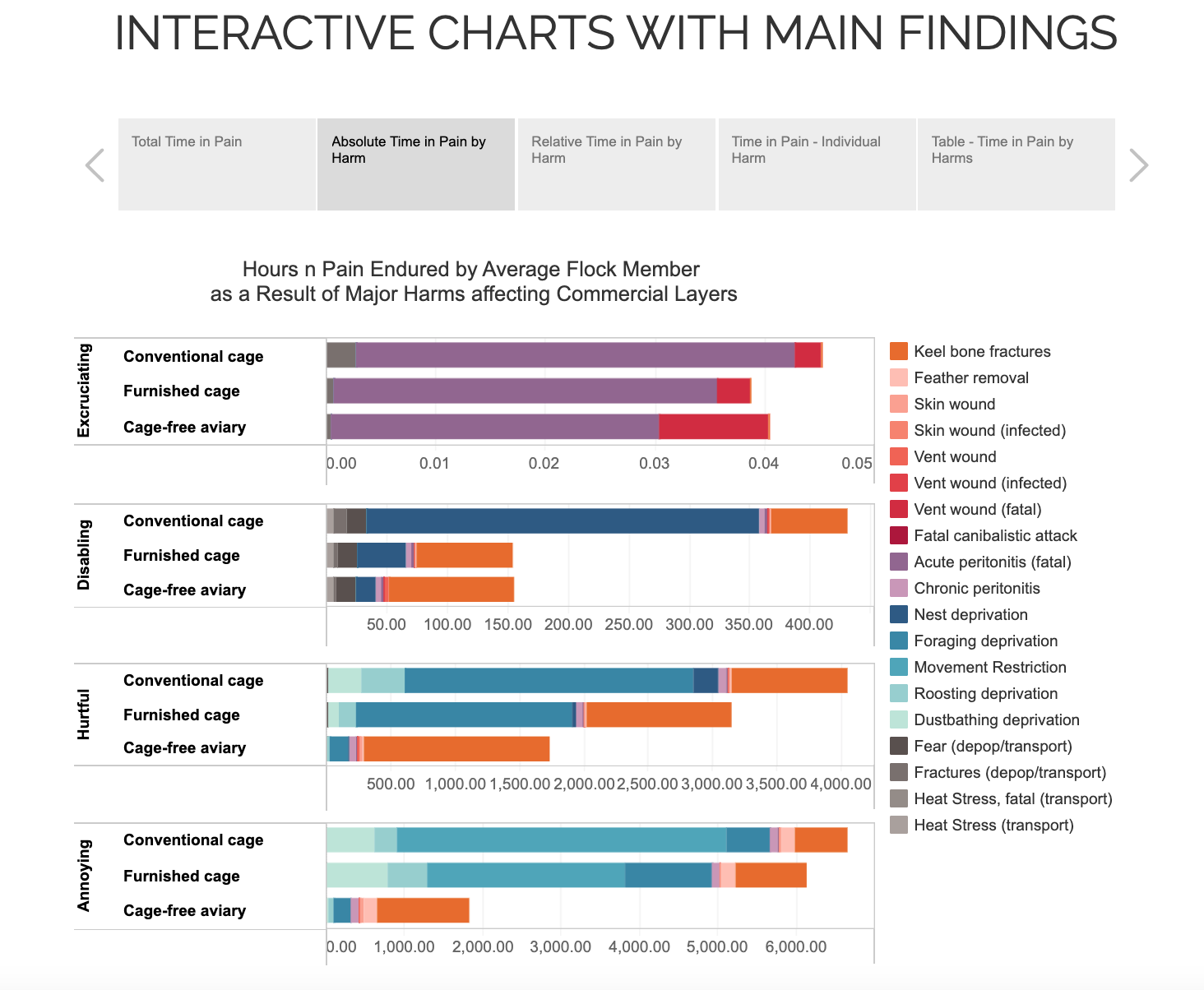Overview
You can find the project here: https://welfarefootprint.org/
WHAT IS THE WELFARE FOOTPRINT PROJECT?
A multidisciplinary research effort to measure the ethical “footprint” of animal-sourced products and services. It seeks to quantify the cumulative effect of the negative affective experiences of animals involved in any activity using a meaningful metric: time in pain (physical or psychological). The project brings together scientific evidence from multiple disciplines, rigorous analytical processes and transparency to inform decision-making.
This is a project run by Drs. Cynthia Schuck-Paim and Wladimir J. Alonso from the Center for Welfare Metrics, who have received funding from Open Phil for this and related work (2018, 2019, 2020) and recently published a meta-analysis on mortality rates in different housing conditions for egg-laying hens (with Dr. Elsa Negro-Calduch).
So far, they have finished or are working on research on:
- methods
- cage-free reforms for egg-laying hens
- the Better Chicken Commitment and slaughter for chickens farmed for meat
- welfare reforms for pigs
- salmon welfare
- wild animal welfare
- global health risks of compromised farm animal welfare
Highlight: Cage-free is far better for egg-laying hens
Highlighting the results of one research project, they've concluded that cage-free is in fact far better than conventional cages in terms of time spent at various intensities of pain. They illustrate this in a chart (it's more readable on their website):

Their main findings are:
- Cage-free aviaries were found to be clearly superior to conventional cages and furnished cages, with an average of 275 hours of disabling pain, 2,313 hours of hurtful pain and 4,645 hours of annoying pain prevented for each hen raised in an aviary instead of CC, and 1,410 hours of hurtful pain and 4,065 hours of annoying pain prevented for each hen in an aviary instead of a FC.
- The estimates are based on the prevalence of the welfare conditions examined as reported for commercial settings in the literature. Therefore, they reflect a situation where the technological, genetic and managerial maturity of cage-free housing is not yet on par with that already achieved by caged systems, indicating that egg-laying hens endure considerably less time in pain even soon after transitioning to cage-free systems;
- Other factors, not analysed, are expected to potentiate further the adverse effects of caged production. Among these are a perceived lack of control in caged environments (associated with a depressive-like state of helplessness), higher levels of fearfulness in cages, the impossibility to enjoy positive experiences that could compensate for some of the adverse effects experienced, longer laying cycles and a higher prevalence of induced molting in cages (in countries outside Europe) and a likely higher prevalence of critically ill birds at the last weeks of life.
- The longer time in pain in caged systems stems predominantly from the deprivation of highly motivated behaviors;
- Most pain endured in cage-free production results from ailments associated with intense breeding for productivity;
- Keel bone fractures are the most important welfare concern in cage-free aviaries;
- The time in pain due to injurious pecking (skin and vent wounds, cannibalism) was substantially lower than that resulting from other challenges;
- Approximately 2,000 hours of excruciating pain are expected for every flock of 50,000 laying hens (1-3 hours per individual affected)
- Egg peritonitis syndrome, a production disease kept out of the research scope, was the main source of intense pain in all systems given its possible evolution to sepsis and the chronic nature of the pain endured by many of those hens surviving the disease.
They are publishing a book on the subject titled "Quantifying Pain in Laying Hens: A blueprint for for the comparative analysis of of welfare in animals", available free online here, and they welcome feedback.
I have not taken the time to check their models and sources in detail, but I consider this to be the most rigorous, best-evidenced and thorough quantification of the welfare differences between housing systems for egg-laying hens to date, far better than anything so far. I am excited to see what other research they will produce!
They're hiring!
They are also hiring for consulting work on the assessment of pain in broiler chickens!
They will also be looking for collaborators soon on salmon welfare and ask you to get in touch if interested.

This is really impressive work. I've been looking for something like this to cite for economics work on animal welfare, and this seems well-suited for that.
Most surprising to me is the similar intensity of suffering ("disabling pain") assigned to nest deprivation as the worst of keel bone fractures. This also seems to be one of the main advantages of cage-free systems over caged ones, with foraging deprivation (with the intensity of "hurtful pain") being another, based on their charts. The evidence for both is discussed in chapter 6 of their book. They define hurtful and disabling pain here as follows: